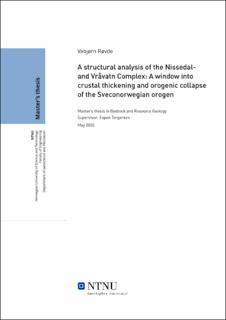| dc.contributor.advisor | Torgersen, Espen | |
| dc.contributor.advisor | Henderson, Iain | |
| dc.contributor.author | Røvde, Vebjørn | |
| dc.date.accessioned | 2021-09-24T17:34:39Z | |
| dc.date.available | 2021-09-24T17:34:39Z | |
| dc.date.issued | 2020 | |
| dc.identifier | no.ntnu:inspera:54974957:22064619 | |
| dc.identifier.uri | https://hdl.handle.net/11250/2781538 | |
| dc.description.abstract | Denne oppgaven presenterer en strukturell og tektonisk analyse av den mesoproterozoiske berggrunnen i Drangedal, som befinner seg i Vestfold og Telemark fylke. Feltkartlegging, kinematisk og strukturell data fra feltarbeid, undersøkelse av mikrostrukturer i mikroskop, samt AMS og EBSD-analyse av utvalgte prøver utgjør grunnlaget for denne oppgaven. Geologien i Drangedal kan bli delt i tre hovedenheter (tektonostratigrafisk oppover): Vråvatnkomplekset, Nisser Detachment Zone (NDZ) og Nissedalskomplekset. Feltområdet inneholder to store deformasjonssoner: (1) En innespent topp-til NV skyvesone i Nissedalskomplekset (kalt Hestkås Thrust Zone (HTZ)), tolket til å være relatert til sen-mesoproterozoisk amfibolitt-facies Svekonorvegisk fjellkjedefolding og resulterende fortykning av jordskorpen. (2) En lav-vinklet, topp-til SØ nedre amfibolitt- til grønnskifer-facies skjærsone, kalt Nisser Detachment Zone (NDZ), tolket til å være ett resultat av neoproterozoisk Svekonorvegisk orogensk kollaps og fortynning av jordskorpen. Skjærbevegelsen i den lav-vinklede skjærsonen (NDZ) og den gradvise fortynningen av jordskorpen resulterte i ekshumering av Vråvatnkomplekset gjennom den sprø-duktile overgangssonen. Det er tolket at de tre geologiske enhetene sammen utgjør ett mulig metamorf kjernekompleks, med Vråvatnkomplekset som det metamorfe kjernekomplekset, NDZ som den lav-vinklede skjærsonen og Nissedalskomplekset som heng-veggen. HTZ og NDZ representerer to deformasjonssoner som er relatert til oppbygging og kollaps av den Svekonorvegiske fjellkjede, som aldri har vært beskrevet før. | |
| dc.description.abstract | This thesis presents a structural and tectonic analysis of the Mesoproterozoic basement rocks in the Drangedal area in the Vestfold and Telemark county. The study is based on field mapping, field structural data and kinematics, and investigations of microstructures with transmittive light microscopy, automated mineralogy system (AMS) and electron backscatter diffraction (EBSD). The bedrock in Drangedal can be divided into three main units (from bottom to top): the Vråvatn Complex, the Nisser Detachment Zone (NDZ) and the Nissedal Complex. The field area exposes two major deformation zones: (1) A constrictional top-to-the NW thrust zone hosted in the Nissedal Complex (here named the Hestkås Thrust Zone (HTZ)), which is interpreted as being related to late Mesoproterozoic amphibolite facies Sveconorwegian thrusting and crustal thickening. (2) A low-angled, top-to-the SE lower amphibolite- to greenschist-facies shear zone, the Nisser Detachment Zone (NDZ), here interpreted as part of the Neoproterozoic Sveconorwegian orogenic collapse and widespread crustal thinning. The crustal thinning and low-angled shearing of the NDZ resulted in the tectonic exhumation of the Vråvatn Complex through the brittle ductile transition zone. Together, the three geological units form a potential metamorphic core complex, with the Vråvatn Complex as the metamorphic core, the NDZ as the low-angled deformation zone and the Nissedal Complex as the hangingwall. The HTZ and NDZ represents two previously undescribed deformation zones related to the growth and collapse of the Sveconorwegian orogen. | |
| dc.language | eng | |
| dc.publisher | NTNU | |
| dc.title | A structural analysis of the Nissedal- and Vråvatn Complex: A window into crustal thickening and orogenic collapse of the Sveconorwegian orogen | |
| dc.type | Master thesis | |
